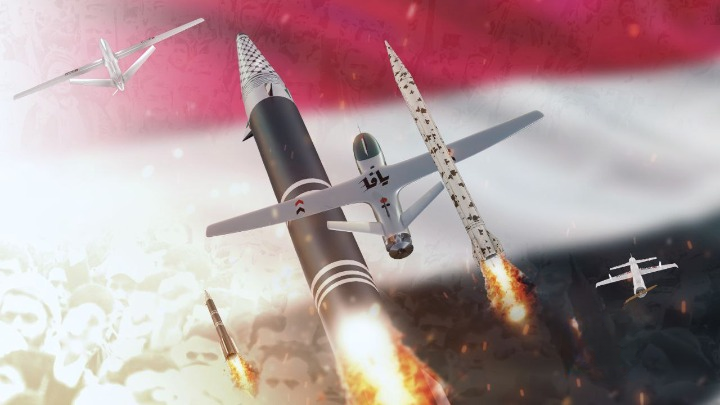Armed Forces Announce Gaza Support Operations: 758 Missions, 1,835 Weapons — The Red Sea Becomes a Field of Deterrence Impenetrable to Aggressors
In a scene underscoring that Yemen’s stance is not mere rhetoric but an act of resistance, the Armed Forces revealed the full scope of their support operations carried out across the theater of confrontation with the Zionist enemy during the campaign “The Promised Victory — The Sacred Jihad.”
The announced figures tell the story of a sovereign decision made with faith and confidence in God — one that transformed cities, ports, and seas into arenas of deterrence, redrawing the rules of engagement and leaving a lasting strategic impact on the calculations of the enemy and its backers.
A Rapid Look at the Numbers: An Operational Epic
Total Operations: 758
Total Projectiles / Weapons Deployed: 1,835 — including ballistic, cruise, and hypersonic missiles; drones; and combat boats.
Naval Operations: 346 missions across a vast arena stretching from the Red Sea and Bab al-Mandab to the Arabian Gulf and the Indian Ocean.
Targeted Ships: Over 228 vessels that violated Yemen’s ban on Israeli-linked navigation or were connected to it.
Air Defense:
22 U.S. MQ-9 reconnaissance drones downed.
40 interception operations against hostile aircraft.
More than 57 missiles launched against aerial formations, bombers, and enemy bases.
These are not mere technical statistics — they are indicators of exceptional capability: the fusion of political will, military sovereignty, and domestic technological advancement, all serving to impose Yemen’s own rules of engagement.
The Sea: A Strategic Line of Defense
The decision to impose a naval blockade and conduct maritime operations has turned the Red Sea, Bab al-Mandab, and the Gulf of Aden into a front that dictates a new reality:
Targeting more than 228 ships has redrawn maritime routes, forcing global shipping companies to reconsider insurance and route strategies.
The shutdown of Israel’s Eilat Port and the suspension of its Red Sea–Mediterranean shipping lanes carry direct economic repercussions for the occupation entity and its maritime trade links.
Naval operations have disrupted the flow of military and logistical supplies to the enemy and forced Western powers to deploy additional warships for protection — stretching their resources thin and increasing their costs.
Missiles and Drones: Technological Maturity and Qualitative Growth
What was impossible yesterday has become tangible today.
The deployment of 1,835 diverse weapons reflects both quantitative and qualitative leaps: ballistic, cruise, and hypersonic missiles; unmanned aerial vehicles; and attack boats.
Penetrating advanced defense systems and inflicting psychological and material losses deep within Israeli territory indicates major tactical and technological evolution grounded in field experience and domestic manufacturing.
Long-range hypersonic and cruise missile strikes have upended deterrence equations and shattered the enemy’s illusion of “absolute security.”
Air Defense: Precision and Resolve
The Air Defense Command achieved:
Downing 22 MQ-9 reconnaissance drones, among the most advanced U.S. models — demonstrating precision detection and targeting capabilities.
40 interception missions, forcing hostile squadrons to retreat, coupled with 57 surface-to-air missiles fired at aggressive formations.
This performance proves Yemen’s ability to challenge aerial superiority, disrupt hostile surveillance, and resist air blockade attempts.
Strategic and Political Impact
Economic and strategic pressure on Israel: port shutdowns, reduced investment flows, and supply-chain disruptions.
Western coalition strain: forced deployment of naval assets for escort duties, resulting in resource diversion and operational fatigue.
Empowering the Palestinian resistance: Yemen’s robust military capability strengthened the Palestinian negotiating position and reshaped the balance of leverage in diplomatic and security discussions.
What Enabled This Performance?
Sovereign decision and popular unity: a coherent political and social front enabling bold, independent action.
Local industrial and technical development: domestic production of missile systems, drones, and naval craft capable of precision long-range missions.
Field experience: years of conflict provided the operational know-how to overcome the enemy’s defensive systems.
Integrated operational management: synchronized coordination between air, sea, and land offensives.
The Human and Spiritual Dimension
The Armed Forces emphasized the moral and faith-driven essence of this campaign: supporting Gaza was not a tactical choice but a religious and humanitarian duty. This stance resonated widely, fueling popular solidarity across Yemen and beyond. Public mobilization and media engagement have become complementary fronts amplifying the message of strength

